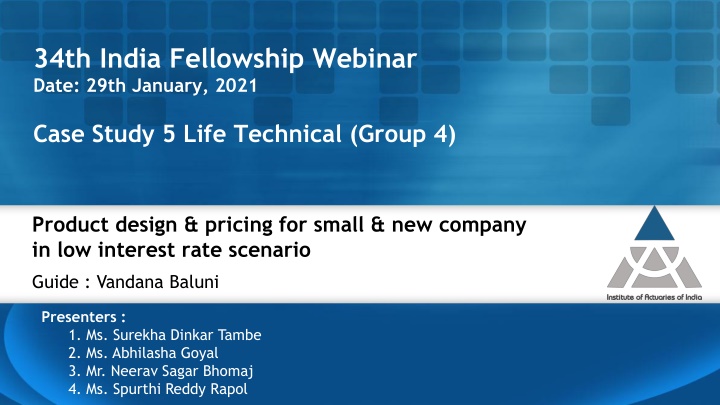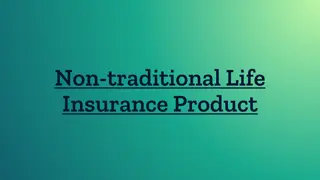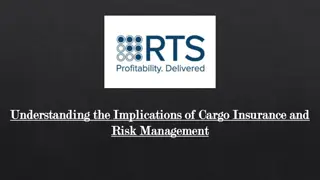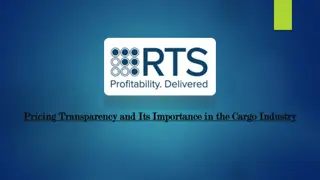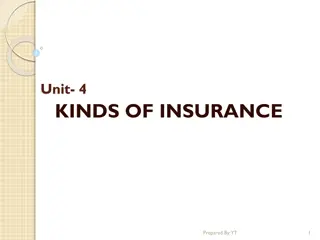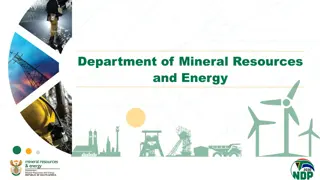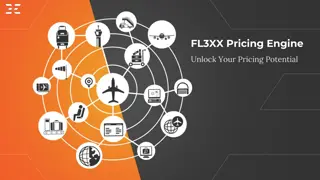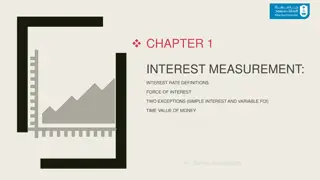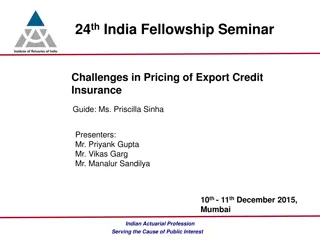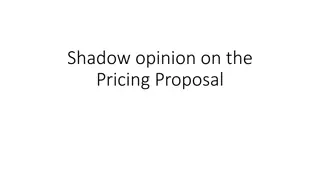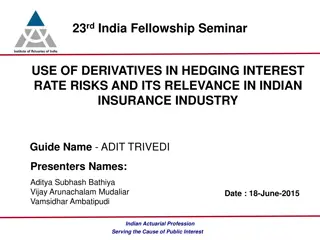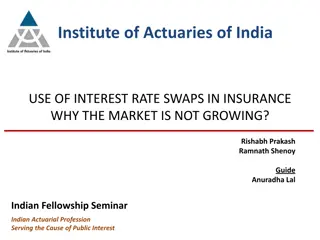Life Insurance Product Design & Pricing Challenges in Low Interest Rate Scenario
Join the discussion on pricing challenges faced by a small life insurance company in a low interest rate environment. Explore strategies for competitive pricing, product differentiation, and effective communication with senior management.
Download Presentation

Please find below an Image/Link to download the presentation.
The content on the website is provided AS IS for your information and personal use only. It may not be sold, licensed, or shared on other websites without obtaining consent from the author.If you encounter any issues during the download, it is possible that the publisher has removed the file from their server.
You are allowed to download the files provided on this website for personal or commercial use, subject to the condition that they are used lawfully. All files are the property of their respective owners.
The content on the website is provided AS IS for your information and personal use only. It may not be sold, licensed, or shared on other websites without obtaining consent from the author.
E N D
Presentation Transcript
34th India Fellowship Webinar Date: 29th January, 2021 Case Study 5 Life Technical (Group 4) Product design & pricing for small & new company in low interest rate scenario Guide : Vandana Baluni5 Presenters : 1. Ms. Surekha Dinkar Tambe 2. Ms. Abhilasha Goyal 3. Mr. Neerav Sagar Bhomaj 4. Ms. Spurthi Reddy Rapol
Case Study - Overview Recently joined as AA of a small and new life insurance company Strategy review in the company to expand aggressively & tap into larger share in the market Current market research identified three most popular products Decided to price 1. Non Linked Non-Participating Saving Product 2. Non Linked Non-Participating Term Product 3. Non Linked Participating Product Product design factors with differentiating aspect between participating Vs non-participating Challenges in pricing such products in the current low interest rate scenario in the covid-19 hit economy. Aggressive and Competitive pricing in current economic scenario, for a small and new life insurance company Managing Interest Rate Guarantee & Communicating professionally with CIO & CFO in regards to differing view on the same. www.actuariesindia.org
Agenda Research Product design factors Challenges for pricing in current low interest rate scenario Aggressive & Competitive pricing Professionalism & Communication to Senior Management Conclusion www.actuariesindia.org
Agenda Research Product design factors Challenges for pricing in current low interest rate scenario Aggressive & Competitive pricing Professionalism & Communication to Senior Management Conclusion www.actuariesindia.org
Research Insurance Penetration 3.70 % in FY 2018-19 vs Global Average of 6% Young Nation : 17.7 % of the total world population reside in India with median age as 28.4 years. Demand for protection: Awareness of the need to have term insurance Why not ULIP ?? Cap on charges/RIY Uncertain economic environment More administration Products Non Linked Non-Participating Saving Product Non Linked Non-Participating Term Product Non Linked Participating Product www.actuariesindia.org
Agenda Research Product design factors Challenges for pricing in current low interest rate scenario Aggressive & Competitive pricing Professionalism & Communication to Senior Management Conclusion www.actuariesindia.org
Product Design Regulation, APS & GN Regulation IRDAI (Non-Linked Insurance Products) Regulation 2019 IRDA ALSM Regulation 2016 APS Appointed Actuary And Life Insurance Business APS 1 Additional Guidance for Appointed Actuaries and other Actuaries involved in Life insurance business APS 2 Appointed Actuary and Principles of Life Insurance Policy Illustrations APS 5 Appointed Actuary (AA) and Principles for determining Margins for Adverse Deviation (MAD) in Life Insurance liabilities APS 7 GN GN 6 - Management of participating life insurance business with reference to distribution of surplus GN 22 - Reserving for Guarantees in Life Assurance Business www.actuariesindia.org
Product Design Factors Distribution Methods Regulator Profitability Marketability Competitive Administration Risk Taxation Customer Needs -Target Market Reinsurance TCF & PRE Capital www.actuariesindia.org
Participating vs Non-Participating Products Definition : A participating policy, as the name suggests, allows its policyholders to share the profits that the company earns. These are shared as bonuses or dividends which makes this a policy with profits. A non- participating policy does not share any profits in the form of dividends and hence is a without profit policy Products : Participating : PH able to see and get the dividends/returns from policy while still alive 1) Endowment 2) Whole Life Non-Participating: Benefits received by nominee of the PH in protection product 1) Term 2) Endowment www.actuariesindia.org
Participating vs Non-Participating Products Differentiating Factors Governance Participating Non-Participating PRE Bonus Policy , Sales Literature, BI, Common market practice, past documents issued, life insurers current practice GN 6 WPC Committee - Independent Director, CEO, AA, Independent Actuary With Profit Fund Management Expenses Allocation, Assets Share, Disclosure in Annual Report In smooth progression of Assets Share GN - 6 = AS/ SV within certain specified range Guaranteed (SA) + Non-guaranteed(Bonus) Relatively less governance GN-22 BI, Sales literature Surrender Value Smooth progression towards maturity value Guaranteed Risk Averse, life & financial protection 100% profit belong to SH Benefits Target Audience Risk Taker(Relatively),wealth creation Profit Distribution Distribution of surplus in 90:10 ratio (IRDA distribution of surplus regulation 2002) Lower saleability due to discretion in bonus rates, less transparency www.actuariesindia.org Marketability With interest rate guarantee saleability can be increased, More transparency
Participating vs Non-Participating Products Differentiating Factors Participating Non-Participating Estate Undistributed Surplus Use in Solvency Capital(ASM) Sufficient Estate, then self sustainable Relatively low risk - Sharing of the risks with PH Relatively capital intensive product High investment risk for Saving. Extensive ALM required (IRDAI ALSM regulation- 2016) Risk Term : No return Saving : Either interest rate guarantee/Increased maturity amount Forms of Returns Revisionary Bonus Terminal Bonus Saving : Guaranteed returns Non Saving : No bonus Bonus Bonus rate function of Investment performance, Expense Management, Smoothening Philosophy discretions of the insurer(Keeping PRE) Higher premium due to saving nature of the product Premium Lower premium for Term Insurance policies(Protection) www.actuariesindia.org
Agenda Research Product design factors Challenges for pricing in current low interest rate scenario Aggressive & Competitive pricing Professionalism & Communication to Senior Management Conclusion www.actuariesindia.org
Pricing considerations External environment 1) 2) Compliance with regulations, APS and GN Economic environment (currently low yield COVID hit economy) Shareholder expectation Policyholder expectation Generating higher value for shareholders (profit margin) Meeting needs Higher guaranteed return Manage risks Competitive premiums With professionalism www.actuariesindia.org
Economic scenario Low Interest rate COVID hit economy In the weak economy, actions taken by RBI of cutting repo rate and reducing cash reserve ratio have resulted in yields falling 10Y G-sec has fallen by ~60bps over the year and ~200bps since June 2018. While the curve has started to recover, and there is a forecast suggests there will be recovery in yields by 2021, however, there is a lot of uncertainty for future and curve can swing in either direction or remain flat Yields Down Profit Margin Expenses PH IRR Investment return Source: TradingEconomics www.actuariesindia.org
Challenges in pricing Low interest rate COVID hit economy Investment Return Challenge is to find appropriate short-term and long-term asset mix to match the liability (inclusive of guarantees) appropriately: Reinvestment risk of future net cashflows at unknown (lower yields) Credit risk higher chance of credit default, recent default of IL&FS highlights this concern further. Regulatory restriction As per the Investment Regulation of 2016, there are restrictions on admissible assets as well as limits to exposure to asset classes. Protection Savings Participating www.actuariesindia.org
Challenges in pricing Low interest rate COVID hit economy Policyholder behaviour Its challenging to predict policyholder behavior in such economic environment, there might be higher than usually expected lapses: there are job losses and pay cuts have led to liquidity crunch distribution challenge - agents unable to service client /difficulty in premium collection Increase in revival period as per (Non-Linked Insurance Products Regulations, 2019) in setting lapse assumption (net of revivals) Increased awareness of need for protection sales might increase Protection Savings Participating www.actuariesindia.org
Challenges in pricing Low interest rate COVID hit economy Expenses If persistency continues to fall it shall lead to increase in per policy cost Fall in NB vol and change in mix shall defer the point of overrun elimination Increase in development cost due to need of digitalization Protection Savings Participating Mortality Increased mortality rate in short term Unknown long-term trend yet to develop Reduced underwriting leading to fraud Reinsurance rates have been volatile Protection Savings Participating www.actuariesindia.org
Challenges in pricing Low interest rate COVID hit economy Others Higher uncertainty may lead to higher reserves resulting in higher new business strain Lack of credible data due to new company and furthermore economic uncertainty Innovative differentiators to remain competitive rider for COVID, cover for job loss in pandemic Protection Savings Participating www.actuariesindia.org
Agenda Research Product design factors Challenges for pricing in current low interest rate scenario Aggressive & Competitive pricing Professionalism & Communication to Senior Management Conclusion www.actuariesindia.org
Aggressive & Competitive Pricing What does it mean? Lower premium, higher benefits Higher policyholder IRR Lower profit margin Higher level of bonuses High surrender values Implications Increased market share New business strain Implications on bonus structure Impact on expenses www.actuariesindia.org
Evaluation by performing analysis Project investment returns Use of stochastic models to project return on assets Use ALM to find out most appropriate investment strategy ALM Allow various economic scenarios especially where interest rates fall and lapses reduce Check whether high levels of bonuses are sustainable ESG and cost of guarantees Check when solvency will fall below minimum internal threshold. Solvency forecast Sensitivity analysis and scenario testing Check if lapses on old products have increased since competitor launching high guarantee products Investment instruments Availability and duration of hedging instruments, partly paid-up bonds, zero coupon bonds www.actuariesindia.org
Risk Management Underwriting Reinsurance Interest rate derivatives Credit default swaps Minimise risk Change in interest rates Change in availability of hedging instruments Competitor repricing Achieving certain business volume At certain level of free capital Trigger points for repricing or restructuring Prepare for unforeseen circumstances Need for capital, issues regarding equity capital Subordinated debt Financial reinsurance www.actuariesindia.org
Agenda Research Product design factors Challenges for pricing in current low interest rate scenario Aggressive & Competitive pricing Professionalism & Communication to Senior Management Conclusion www.actuariesindia.org
Differing views Views on Senior Management (CIO and CFO) Appointed Actuary Interest rate guarantee Economic scenario will normalise within a year Uncertain when it would normalise Assets locked for low investment return when held to maturity. Life Insurance is long term hence nothing to worry Reinvestment risk - Assets shorter term than liabilities Derivatives can be used to hedge interest rate risk. Secondary risks from derivatives Eg. Counterparty risk, roll forward risk, removes upside risk, risk of rebalancing Investment Strategy Existing Investment strategy can be continued Existing Investment Strategy unsuitable - new objectives and characteristic of liabilities Small changes in interest rate will impact liabilities more than assets Asset Liability Modelling (duration matching) can be used to develop an appropriate Investment strategy www.actuariesindia.org
Professional issues and Communication Interest rate guarantee Hedge using Derivatives Professional Considerations Communication with Senior management Assets Liabilities Interest rate derivatives Prescribed Guidelines on Interest Rate Derivatives Valuation Interest Rates needs to comply with APS1 and APS2 Information presented - simple to understand. Range of economic scenarios and their implications E.g. Provide a range of interest rate scenarios and their influence on the profitability. Sufficient margins for adverse deviations (MAD) as per APS7 Interest Rate guarantee reserve can be quantified using Stochastic or Deterministic Models as per GN22 Cost vs Benefit of the strategies must be conveyed www.actuariesindia.org
Professional issues and Communication Investment Strategy Asset Liability Modelling Professional Considerations Communication with Senior management Assets Liabilities Setting Investment Policy - IRDAI Investment Regulations, 2016 Consistency in valuation of assets and liabilities Quantifiable objectives and respective investment strategies can be compared and presented to the CIO and CFO Asset Liability Matching by duration Guidelines as per IRDAI Circular on ALM and Stress Testing, 2012 E.g. Expected solvency level for each investment strategy can be compared www.actuariesindia.org
Agenda Research Product design factors Challenges for pricing in current low interest rate scenario Aggressive & Competitive pricing Professionalism & Communication to Senior Management Conclusion www.actuariesindia.org
Conclusion Aggressive and Competitive Pricing for market penetration can be met Appropriate Risk Management Process Suitable Investment Strategy Focus on protection products Continuous monitoring withdraw, re-price, re-design, change sales strategy Achieve Synergies to lower expenses Digitalisation www.actuariesindia.org
Thank You www.actuariesindia.org
